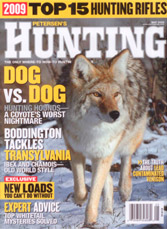Serengeti Gunstock - Attractive & Stable
Strength, Stability & Beauty: The Innovative Serengeti Gunstock
Guns Magazine - John Barsness
(March 2009)
Wood is the traditional material for rifle stocks because for many centuries it was the best material for the job, hardwood in particular. It is reasonably light and can be precisely carved to both fit the metal parts and the human who holds the rifle. Many different hardwoods have been made into rifle stocks, but the top choice the world over is some sort of walnut, whether the tough but relatively light Eurasian walnut or the slightly heavier but more showy American black walnut.
One problem with walnut stocks is wood never really does settle down, even long after the tree it came from is cut down, sliced into smaller pieces, and "cured" by drying for several years. These dimensional changes are caused by atmospheric moisture, or the lack of it. The cells of the wood shrink and swell, depending on how much water is in the air, the individual piece of wood, and how it is finished.
In fact, wood never stops squirming even after being coated with modern synthetic finishes. This didn't matter much when the rifle was a muzzleloader intended for relatively close-range shooting at rather large objects, but that changed when rifles became super-accurate, however we want to define the term. When a walnut stock squirms, both accuracy and the rifle's point of impact can be affected, and this was the inspiration for the synthetic stock so common today. Synthetics have stopped the squirming, at least any squirming due to moisture. (Temperature is another issue, but not the subject here.)
Many shooters, however, still prefer the feel and looks ,of walnut stocks. This is not entirely esthetic, though thank the Hunting Gods almost no synthetic stocks are painted to look like wood these days. Walnut is warmer to the touch, and quieter when it encounters other objects, such as the living trees that tend to inhabit hunting habitat.
At its best wood is also undeniably beautiful, and at least a percentage of humanity has always liked good-looking weapons. Even Stone Age knappers apparently like to make spear-points out of nice-looking rock, and the spear hafts were often decorated with paint, leathers, leather and whatever else looked good. Thus it was only natural when humans started using firearms to pimp out their rifles.
One way to keep walnut squirming to a minimum it to glue layers of it together, as in plywood. Laminated stocks have been around for longer than most of us realize, but until recently most were made of many thin layers, often of contrasting woods, not all walnut. These stocks are considered attractive by some, but more conservative shooters tend to think anybody who'd use a striped rifle would also insist on white-line spacers.
There is another solution. Several years ago I got a phone call from a Montana gunsmith named Mel Smart, who built laminated gunstocks with thin layers only in the middle of the stock. Each side of the stock was a single piece of thicker wood, so it could be made out of attractive walnut. He sent me a sample made for a standard Remington 700 BDL and, after some minor epoxy bedding of a factory .30-06 barreled action, I used it for several years, both in North America and Africa, in a lot of different weather. The rifle never shifted point of impact, and looked pretty good.
Mel died a few years ago, and the firm was purchased from his widow by a group headed by Rod Rogers, who had worked in Mel's shop. They did some more experimenting with the method, and found a single thin layer sawn out of the middle of a stock blank, then reversed and glued inside the outer layers, made a stock as stable as one with more layers. They hired professional stockmakers to create even nicer-looking stocks, and Serengeti Stockworks was born.
Attractive And Stable
My first contact with them was on a prairie dog shoot in eastern Montana, where I shot several Serengeti-stocked rifles. All shot very well, and looked great. Some of these were complete custom rifles on various actions. A couple of years later I ordered a complete Serengeti rifle, a 7x57 on a slightly fancy piece of American walnut and a Montana 1999 action.
It looked pretty darn good and proved to be very accurate as well as stable. One advantage of a laminated stock on a light sporter is the barrel channel can be fully bedded. This bedding method isn't often seen on factory rifles, which tend to have either free-floated barrels or what is called "tip-bedding," a high spot near the tip of the fore-end that exerts some pressure on the barrel. Instead, full-bedded fore-ends have equal barrel pressure all the way down the fore-end. This is not only relatively expensive to do in mass production, but in a walnut-stocked rifle tends to create problems when the wood inevitably starts to squirm.
However, full bedding does tend to make lighter barrels shoot very well, one reason it's often used by many custom gunsmiths who make synthetic-stocked rifles. With the Serengeti laminates, full bedding works great as well. I liked the stability of my 7x57 so much I eventually had to have a really fancy Serengeti stock, but couldn't afford both their top grade of blank ($1,500 or even more) plus another custom action and barrel. So instead I had them restock my CZ 550 in 9.3x62, which over the past few years has become my favorite medium-bore hunting rifle, having taken game from British Columbian moose to South African kudu.
The results were spectacular. The wood is a fantastic piece of Eurasian walnut, carved in Serengeti's Cheetah profile, a slim stock. The buttstock's straight-topped comb drops a little toward the action, and has a shadow-line cheekpiece. The fore-end is a Schnabel, reflecting the rifle's European heritage, and the grip has a rosewood cap. The checkering is a multi-point pattern, with 20 lines per inch. Not only does it look a lot better than the piece of plain firewood from the factory, but the rifle dropped half a pound as well. It now weighs exactly eight pounds with a Leupold FXII 4x33 in Talley steel mounts, and shoots even better than it did from the factory.
This was always a very accurate rifle, but the 3-shot test group Rod Rogers fired with 286-grain Nosier Partitions and Reloder 15 powder measured just over 1/2"--and the rifle has not changed point of impact since that day in the spring of 2008. Now we can have our walnut and shoot it too.
For More Information about Kilimanjaro custom rifles contact:
Erik D. Eike
President, Kilimanjaro Rifles
707 Richards Street - Suite 201
Honolulu, Hawaii 96813
Toll Free: (877) 351-4440
Cell: (808) 292-4534
Fax: (808) 537-5955
Email: eike@kilimanjarorifles.com
Web: www.kilimanjarorifles.com
MEDIA HIT

Sporting Classics
May/June 2014
"Classy to look at and a pleasure to carry, the Kilimanjaro Tigercat functions flawlessly and promises consistent accuracy, outing after outing, year after year."
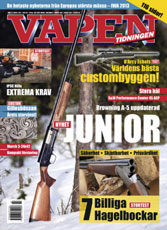
Vapentidiningen
March 2013
"My priority was to fullfil my hunting passion - to hunt down old buffalo bulls. I did, with great enthusiasm, with my new Kilimanjaro Doctari Professional Hunter rifle in .505 Gibbs..."

Sports Afield
Nov/Dec 2012
Diana Rupp
South Island Safari
A mountain-hunting adventure amid the soaring peaks of New Zealand's Southern Alps.
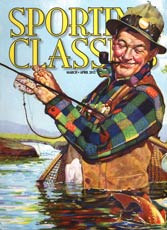
Sporting Classics
Mar/Apr 2012
Award Of Excellence
Kilimanjaro receives the Sporting Classics' Award of Excellence. "The Kilimanjaro rifle proves that old adage: There's always room at the top."
–Ron Spomer

Sports Afield
Mar/Apr 2012
John Barsness
Enough Gun
The New Doctari Rifle
from Kilimanjaro is the ideal rifle for taking on the World's biggest game.
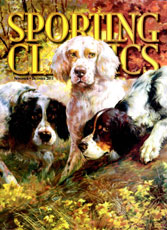
Sporting Classics
Nov/Dec 2011
Ron Spomer
The Doctari 505 Gibbs has the handling qualities of a fine double shotgun and ballistics of a howitzer.
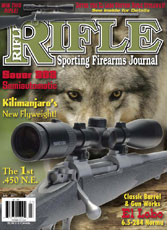
Rifle Magazine
July 2011
Ron Spomer
Kilimanjaro's Walking Rifle - The Perfect Flyweight Hunting Rig
"Okay, so it's a dream rifle. We all have them, don't we?...

Sports Afield
May/June 2011
John Barsness
Kilimanjaro's latest masterpiece, Kilimanjaro African .375 H&H, shown on the cover of this issue, features an Exhibition Grade Bastogne Walnut stock...

Texas Sporting
November 2010
Jameson Parker
Any man with enough moxie to buy a failing custom gun company just as the economy lurches into the deepest ditch since the Great Depression is clearly a man who enjoys taking risks.

Texas Sporting
September 2010
Jameson Parker
There are few words more evocative of adventure than Kilmanjaro, the name of Africa's highest mountain,

American Rifleman Patriot Review
August 2009
Ron Spomer
Serengeti is unique among classic rifle builders because they build not just on super-fancy walnut stocks, but laminated ones as well...
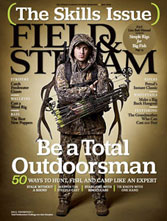
David E. Petzal,
Field & Stream Magazine, February 2006
"Serengeti… builds laminated walnut stocks that are stable yet look like natural wood…. How natural? My gun dealer, who handles many high-grade firearms...
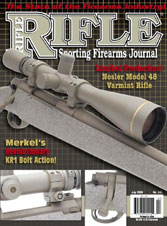
John Barsness,
Rifle Magazine,
January 2006
A couple of years ago an itch started for another rifle, thanks to Serengeti Rifles. These folks make what might be termed "cutting-edge classics," bolt-action hunting rifles...
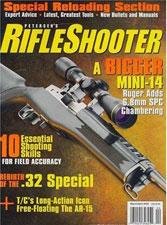
John Haviland,
Rifle Shooter Magazine,
January 2006
"Montana craftsmen don't believe that strength must be sacrificed for beauty…. The rifle is, in a word, concise. It's as light as a thin cloud, yet its stock provides a sure grip...
